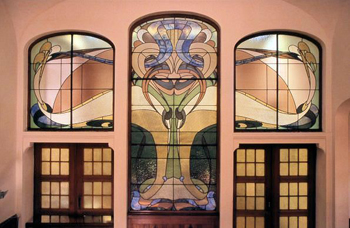Product Description
Henry van de Velde Silver mounted Eugene Baudin French Art Nouveau vase c. 1900


HENRY VAN DE VELDE (1863-1957) Belgium (design mount)
for “LA MAISON MODERNE” Paris, France
ALPHONSE-EDOUARD DEBAIN France (execution mount)
EUGÈNE BAUDIN (1853-1918) France (pottery)
Vase c. 1900
Matte-glazed pottery, cranberry bright turquoise and white highlights, elaborate Art Nouveau whiplash silver mount.
Marks: E Baudin, AD (silversmith monogram), French 950 silver assay mark
For more information on van de Velde ceramics see: Ceramics of the 20th Century, Tamara Préaud and Serge Gauthier (New York: Rizzoli, 1982) illus. no. 67, p.42; Art Nouveau and Art Deco Silver, Annelies Krekel-Aalberse (New York: Harry N. Abrams, Inc.,1989), pp. 63, 90, 264.
For other A-E. Debain designs see: The Paris Salons 1895-1914, Vol. V: Objets d’Art & Metalware, Alastair Duncan (Woodbridge, Suffolk: Antique Collectors’ Club, 1999), p. 208.
For related Van de Velde mount designs see: Jugendstil, Irmela Franzke (Munich: Battenberg Verlag, 1987), illus. 169, p. 87.
H: 8 1/4” x W: 4”
Henry van de Velde Silver mounted Eugene Baudin French Art Nouveau vase c. 1900
